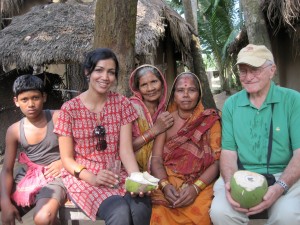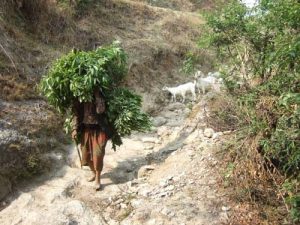This week Paul Polak has guest blogger Bhavna Toor. Bhavna will be talking about the new work Paul has been doing in India.
Meet Bina Behera. She is in her early fifties. She lives on the outskirts of a small village in the Khurda district of Orissa. She earns approximately Rs. 100 a day making small handicrafts and selling them to a local trader. She became the sole bread-winner of the family six months ago after her husband repeatedly fell ill from all kinds of water-borne diseases to the point where he was completely bed-ridden. Over the past year, she has spent upwards of Rs. 10,000 on health-care bills for her husband.
 Spring Health International, founded by Paul Polak, with the goal to provide clean and affordable drinking water to rural areas in Eastern India, partnered with a local shop-keeper in Bina Behera’s village to set up a water kiosk that would provide safe drinking water to all villagers at 20 paisa per liter. One would assume this would be the perfect solution for Bina Behera’s family, saving them considerable lost income and health-care fees from water-related sickness. But it was not; at least not at first. Why? Bina Behera and her family belong to a community of untouchables, also known in India as Dalits.
Spring Health International, founded by Paul Polak, with the goal to provide clean and affordable drinking water to rural areas in Eastern India, partnered with a local shop-keeper in Bina Behera’s village to set up a water kiosk that would provide safe drinking water to all villagers at 20 paisa per liter. One would assume this would be the perfect solution for Bina Behera’s family, saving them considerable lost income and health-care fees from water-related sickness. But it was not; at least not at first. Why? Bina Behera and her family belong to a community of untouchables, also known in India as Dalits.
When another member of her community went to the water kiosk to fill his jerry can, he accidentally touched the water tap for the 3000-liter water tank. This was considered to be such a grave offence by the rest of the villagers that the shop-keeper was forced to empty out the entire water tank, and perform a ritual to purify the water tank that had been rendered impure by “the untouchable”. Following this episode, not a single member of the Dalit community dared to go to the kiosk to purchase water. Therein lay the problem. Market forces alone cannot be the panacea when there are powerful social forces at play.
Untouchability has marred the social fabric of India for over 3000 years. Largely a social construct, Dalits came to be associated with all occupations that were considered to be impure according to Hindu norms, such as leather tanning, butchering, and manual scavenging (the removal of human feces from toilets without a flush, a practice that, though banned, continues in several parts of India till today). As a result, Dalits were historically banned from entering temples, drinking from the same wells as others, and were required to stay on the outskirts of villages. Untouchability was officially outlawed in 1950 by the Indian Constitution, which gave the right to equality and right to freedom from discrimination to all citizens of the country. In practice, however, prejudice against Dalits has been so firmly entrenched into the ethos of Indian society, particularly in the rural areas, that it has been difficult to uproot completely.
Spring Health had quite a conundrum at its hands. Had it been a conventional enterprise, perhaps it would have looked the other way, and been sufficiently satisfied with providing water to a majority of the villagers that are not Dalits (only 12 out of the 100 households in the village are from the Dalit community.) But, because Spring Health has a social mission of equal and affordable access to clean water to all those living on $2 a day or less built into its business model, it looked for a creative solution, and found one.

Spring Health, at the suggestion of their business and design consultant Idiom, started a home delivery system, allowing the shopkeeper to deliver clean water to the hamlet that houses the Dalit households in 10-liter jerry cans, at a small premium. The shop-keeper was happy to try this method as the extra sales increased his revenues, and the Dalit households were happy as they now had access to an income-saving, and potentially life-saving, resource.
The great thing about a market is that it does not discriminate. Anyone who has the ability to pay for a product or a service can theoretically access it, which is why I am a big believer in market solutions to poverty. However, conventional enterprise may not provide an effective solution when strong social prejudices stand in the way. In those instances, it can become all too easy for an enterprise to simply adapt to, and therefore, perpetuate the power hierarchy in society. Whether you call it a social enterprise or not (I know Paul Polak would strongly object to calling Spring Health a social enterprise per se), in order for an enterprise to effectively serve underserved populations, it must have an explicit social mission to do so. Only then will it go the extra mile to come up with innovative solutions to the most intractable social constraints that prevent equal access.
Paul Polak and I went to visit Bina Behera to see the results of the home delivery method. At the time of our visit, 5 out of 12 Dalit households were availing of home-delivered water. To our delight and amusement, Bina Behera candidly reported that she and her family were ritually consuming the clean water almost as if it were medicine. As a form of gratitude, or maybe just sheer hospitality, she offered us fresh coconut water, which we drank immediately. Paul reached out his hand to thank her, while I put my arm around her. Little did we know, these seemingly small gestures filled her with great joy. She grabbed my hand tightly and muttered something in Oriya, which our translator later told us it meant, “You are like a daughter to me. I am so happy you came to visit me.” It was then that we realized, that by “touching an untouchable” we had subtly conveyed to her that she is indeed, not untouchable, but our equal in dignity.
It may take several generations to completely eradicate untouchability from Indian society, but at least with socially-minded enterprise, and the economic empowerment that it creates, we may just be able to give Bina Behera and others like her a fighting chance to avail of the same opportunities as others, and hope for a better life ahead.


how does this transform local society an culture? the most disadvantaged no even have to pay a premium to get their water. and only five out of 12 dalit households avail of this “opportunity”. why not charging a premium to the non-dalit households – who are the majority – and use this to subsidize the water delivery to the dalit households, and to all of them for that matter…?
the problem is that you can’t impose your ideas of justice on the values embedded in local culture. You consider it unjust for untouchables to pay more for water delivered to their homes and so do I. But I think its a better option than not having access to clean water, and even though you may feel that it would be fairer to ask other families to pay more to subsidize water delivered to untouchables, I don’t think it would fly in the local culture.
For a long time, black people weren’t allowed to sit at lunch counters with white people in the rural south of the United States. Do you think a strategy to charge white people more for their food at lunch counters in order that poor people could get their lunches at a fair price at a good lunch counter?
When IDE introduced treadle pumps in conservative Muslim rural areas in Bangladesh 20 years ago, it was considered unseemly for women to operate the pump exposed to public scrutiny, so they usually built a privacy screen around the pump. If the pump broke, women couldn’t go to buy a spare part in a village shop. I didn’t like these cultural values, but I lived with them. Eventually, as treadle pumps generated remarkable new income for rural families who invested in them, the cultural expectations for women began to change, and now many women pump in public and buy spare parts to fix pumps, and gain economic empowerment that changes their lives. In the long run, I believe the economic empowerment from not having to pay for the illnesses caused by drinking bad water will have the same impact on untouchable communities.
Paul Polak
Thats a good start Bhavna …keep rocking .. hope to have real social businesses in coming times …The above looks like a project 🙂 .. A student doing dissertation ..
Much to the contrary: The most distinctive thing about the market is that all it does is discriminate. It divides those with money and power from those without money and power. That is its essential use. And more important, it does so on the basis of the social power of those operating the market.
The way Paul’s apparent use in this case has worked seems to be helpful to the Dalits and to the shop keeper. I can certainly see that as a good thing. There are further questions for Paul and Bhavana to answer, if we are interested in Behera beyond the past tense of the story.
How long will Paul keep up with Behera and the other Dalits in the village to see if the shopkeeper continues to deliver the water? How long will Paul keep up with the shop keeper to see that he is not raising prices on the Dalits? In US, all products are cheaper in the markets when purchased in larger amounts than poor people can afford. The sellers call this the large economy size. But poor people know this as, middle class people pay half as much for the same amount, just because they can buy in greater bulk. That is an essential part of the US market.
And then what of the civic institutions of Orissa, which don’t need to offer water to their people, because the middle classes of the city don’t want to bother building wells for public water supplies? What does Paul do about this?
Longevity in those parts of the world where there is public water shared by all is a good deal higher than in India and even greater than in Orissa where private market water will always be less protected from disease than the public water supply that the middle classes drink and so insure the purity of. Further separating Dalit water from public water makes the Dalits more vulnurable to the manipulation of elites than public water.
Market magic is only useful to the magicians who own the market. Some things like water and land may require public management. In the short run Paul seems to have helped some of the Dalits in this story. But what will happen when he moves on? Or other conditions change?
A strong approach there Paul, the use of business models in social enterprises with rather culturally sound innovative ways is the key strategy in privatization of poverty reduction, where so small villages in the poorest countries have access to operating on funds boosting local ownership and local marketing. More so local communities can build their own capacity for marketing given the lower interest rates from such approaches.
That is sad that they are labeled untouchables because of their jobs. That is ridiculous. This seems like a good program. One thing I would like to know is that the water is not flouridated. If it is I would be very upset. Nice article!
Having been worked with IDE in India over 8 years in many states like Rajasthan, Gujarat, Karnataka, AP and Tamilnadu, I have came across several such situations where in the upper cast community having great level of reluctance and resistance to treat the dalits as same as them. While we were working in Kachh-Gujarat for the earthquake rehabilitation program, we employed both the upper cast and others in our field team. And I witnessed the great level of happiness among the dalits while the uppercast (They are called “BAPU”) staff interacted with them without any hesitation or difference. It is very important to deal with issue sensitively and adopt an appropriate action while encountering with such extreme sensitive issues. As Paul explained about the Bangladesh example, in due course of time as the economic status improves, such differences would shade away. Appreciate the right approach taken in this case.
Bhavna, I am also an admirer of Paul Polak’s methodology and tactics, coming to your blog via the post at his Out of Poverty group . I’ve adopted adopted Paul’s methods in our work to end hunger, which has developed into the Reconomy project at http://reconomy.net. This project is focused especially on those whom have no or little money – earning less than the World Bank’s poverty line. Reconomy recognizes that irresponsible exploitation of human and natural resources is the ultimate cause of poverty. Consequently we’ve adapted our approach to serve every community with a single core strategy, which is to discount an essential resource with a local money that we offer to pay people to develop that resource. Our workers might choose to be paid in national currency but the demand for the resource creates a demand for our currency, and this currency stays in communities empowering them to both develop and to control all of their local resources. This approach is aimed at all communities because communities that develop and control their own resources are not only enabled to end their own poverty but also to stop exploiting others.
To reach the poorest people with this local money we provide work developing an essential resource at the simplest level. For our pan-community strategy we are developing and discounting electricity because much like money it facilitates development of all other resources in all communities. And so in the poorest communities our strategy begins by paying people to generate electricity using pedal-power. The cost of producing energy in this manner competes very well with kerosene for lighting, providing a margin for the smallest businesses, which is described in our benefit-cost analysis.
We’ve chosen India for our developing world pilots because of the close proximity of grave poverty and prosperity. History has demonstrated that local currencies do well where national currencies are scarce, and that they whither when national currency returns because national currency is more powerful…and then national currency resumes exploitation. Our pilots look to demonstrate that the discount confers a bonus value that enables local currency to flourish even in the most challenging circumstances, creating genuine local marketplaces that empower communities to resist that exploitation.
In India there is another deep challenge that you address in your blog, which is the entrenched class prejudice. It seems to me that the caste system is what defines India, uniting disparate cultures within a common marketplace. Untouchables confer untouchability to everything they touch, but to varying degrees, and perhaps money is the most common exception. In the example you site, the shopkeeper must purify his water and the solution becomes special delivery, but some of the money that shopkeepers receive from lower castes generally circulates upwards un-cleansed, and onward across all classes.
So, what will become of local money that is more powerful than national money in the purchase of electricity? The answer will probably vary by degree from village to village and from person to person. All labor tends to default to the lowest class that engages in it, and it seems likely that that prejudice will also taint the local currency offered for that labor more than the national currency. In this circumstance, the prejudiced will use rupees to replace their kerosene lighting with our superior LED technology, and their disdain for our currency might slow the development of a local marketplace using this currency. However, it will enhance the development of businesses that engage in commerce with our currency and with the lower castes, empowering them to develop local resources, and tending to transfer control of those resources to the lower castes.
Thus it seems to me that this alternative currency might transform the communities in which it is used, ending poverty and ending the caste system, and that this logic holds true to some degree in every community everywhere in the world, for how can poverty exist without prejudice. Who does not let their own children eat first?
Ahaa, its nice dialogue about this article here at this webpage, I have read all that, so at this time me also commenting here.